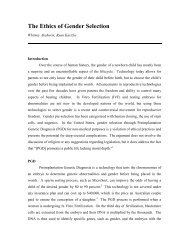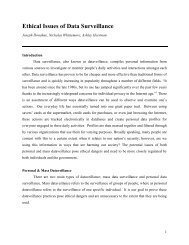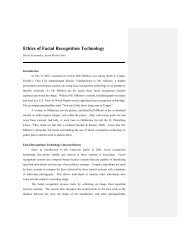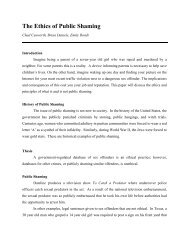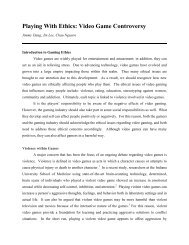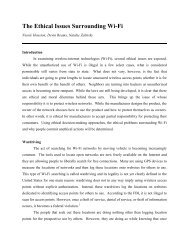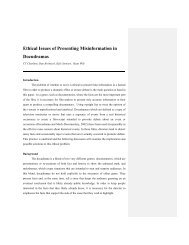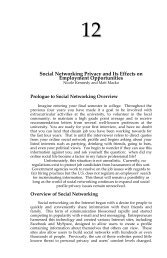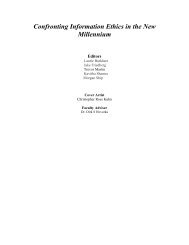The Ethics of Stealth Marketing - Ethicapublishing.com
The Ethics of Stealth Marketing - Ethicapublishing.com
The Ethics of Stealth Marketing - Ethicapublishing.com
You also want an ePaper? Increase the reach of your titles
YUMPU automatically turns print PDFs into web optimized ePapers that Google loves.
Undercover Agency<br />
<strong>The</strong> <strong>Ethics</strong> <strong>of</strong> <strong>Stealth</strong> <strong>Marketing</strong><br />
By: Alexandria Weisberg, Alonna Pfleiger, Jake Friedberg<br />
“Excuse me sir,” the young man asks politely as you pass by him. “But would you mind<br />
taking a picture for us?” He smiles that same awkward little smile that everyone does when making<br />
that particular request and holds out a shiny new Sony-Ericsson camera phone. “Just one quick<br />
pic? We’re on our honeymoon.” You have a million things to do, and you are late already, but they<br />
seem like nice kids, so reluctantly, you agree. “Thanks man, I really appreciate this,” he says as he<br />
shoves the phone into your hands. “Have you ever used one <strong>of</strong> these before?” he asks, but before<br />
you get a chance to answer, he launches into a lengthy description <strong>of</strong> the device’s various<br />
impressive features. “Wow, ” you think as the device snaps a clean, crisp little picture <strong>of</strong> the<br />
newlyweds. “This thing is pretty cool.” He thanks you again as you hand him back the phone and<br />
it’s not until you are halfway home that you realize that neither <strong>of</strong> them was wearing a ring.<br />
Introduction<br />
In late July <strong>of</strong> 2002, the Sony-Ericsson Corporation hired 60 actors to travel to various<br />
cities across the country posing as tourists and ask people passing by to take their picture with the<br />
<strong>com</strong>pany‟s latest and greatest creation: the camera phone. Sony-Ericsson did not set up any<br />
promotional materials at the sites, and the actors were instructed not to introduce themselves as<br />
representatives <strong>of</strong> the <strong>com</strong>pany. Instead, the <strong>com</strong>pany wanted the entire situation to feel “natural”<br />
as the stunt was designed to make consumers feel like they had “stumbled” onto a hot new product.<br />
It is unclear how successful the campaign was, but the “fake tourists” did reach a large number <strong>of</strong><br />
people, and the stunt received national media attention.<br />
In a world where everything from bowl games to satellite launches are corporately<br />
sponsored, we are literally inundated with advertising on a daily basis. As a result, consumers are<br />
be<strong>com</strong>ing desensitized to the entire phenomenon <strong>of</strong> marketing. Additionally, new technology is<br />
giving us unprecedented control over our media. <strong>The</strong> growing prevalence <strong>of</strong> DVRs (digital video<br />
recording devices), caller ID systems, and Pop-Up and SPAM blocking programs is increasingly<br />
granting us opportunities to simply ignore advertisements altogether. Recent shifts in advertising<br />
trends have forced many <strong>com</strong>panies to seek new, creative methods to reach their perspective<br />
customers. One such tactic, as the above example demonstrates, has been to disguise the fact that<br />
marketing is occurring altogether. <strong>The</strong> idea is that consumers can not ignore what they are not<br />
aware <strong>of</strong> in the first place. Marketers are calling the new phenomenon “stealth marketing,” and it<br />
may just be<strong>com</strong>e the future <strong>of</strong> advertising. However, such techniques are ethically questionable<br />
because they use deception to get their message across. Specifically, because it does not identify<br />
itself as advertising, stealth marketing robs individuals <strong>of</strong> the choice <strong>of</strong> whether or not to<br />
participate in the promotion. Thus, the question then be<strong>com</strong>es: Should consumers be allowed to<br />
control when, where and how they are marketed to?<br />
1
<strong>The</strong> goal <strong>of</strong> any marketing campaign is to induce a change in behavior in the people that it<br />
reaches. Whether it is a change in buying behavior, voting preferences, or personal values,<br />
advertising attempts to convince us to alter how we are currently acting. <strong>The</strong> party sponsoring the<br />
ad is the one directly benefiting from the message conveyed. However, people are be<strong>com</strong>ing<br />
increasingly skeptical <strong>of</strong> advertisements due to recent tactics that lack both sincerity and credibility.<br />
Whether the persuasion is <strong>com</strong>ing from a <strong>com</strong>pany wanting you to buy their product, or from a<br />
candidate seeking your vote, there is a tendency for a bias to derive from the one who is funding<br />
the marketing campaign.<br />
What people truly value when making purchasing decisions is the advice <strong>of</strong> a<br />
knowledgeable, unrelated third-party whom they trust. For example, hearing your mother tell you<br />
that she always buys JIF brand peanut butter will most likely have a far greater affect on your<br />
buying habits than a TV <strong>com</strong>mercial promoting the same product. Marketers call this sort <strong>of</strong><br />
personal interaction “Word <strong>of</strong> Mouth <strong>Marketing</strong>” or WOMM, and it is widely valued as the most<br />
effective method <strong>of</strong> inducing the purchasing changes desired by advertising agents. <strong>The</strong> obvious<br />
challenge posed by WOMM is getting the public to talk favorably about your product.<br />
<strong>Stealth</strong> marketing is one tactic that marketers have invented to solve this problem.<br />
According to Andrew Kaikati and Jack Kaikati, “<strong>The</strong> main objective <strong>of</strong> stealth marketing is to get<br />
the right people talking about the product or service without it appearing to be <strong>com</strong>panysponsored.”<br />
1 In other words, stealth marketing attempts to get influential people excited enough<br />
about a product that they will use and discuss that product with others. However, as Kaikati and<br />
Kaikati also mentioned, stealth marketers specifically attempt to achieve this goal without letting<br />
people know that they are being marketed to. And this is what makes stealth marketing ethically<br />
controversial; it is designed to deceive people into paying attention to advertising. <strong>The</strong> overt nature<br />
<strong>of</strong> traditional advertising allows the public the choice to either be<strong>com</strong>e engaged or not. With<br />
stealth marketing techniques, consumers are <strong>of</strong>ten not aware that they are being advertised to until<br />
the end <strong>of</strong> the exercise, if they are alerted at all.<br />
Subsets <strong>of</strong> <strong>Stealth</strong> <strong>Marketing</strong><br />
<strong>The</strong>re are three main subsets within stealth marketing that are be<strong>com</strong>ing both increasingly<br />
popular among advertising firms and increasingly controversial among consumer advocacy<br />
groups: product placement, video news releases, and Guerilla <strong>Marketing</strong>.<br />
Product Placement<br />
In the field <strong>of</strong> marketing, agencies must continuously invent new ways to capture an ever<br />
changing audience. Product placement is a technique marketers began to experiment with decades<br />
ago after discovering how effective the technique can be. <strong>The</strong> term product placement is used to<br />
describe a promotional tactic in which a real <strong>com</strong>mercial product is used in fictional or<br />
non-fictional media, and the presence <strong>of</strong> the product results in an economic exchange. 2 Products<br />
first started appearing on quiz shows in the 1950s when <strong>com</strong>panies realized the shows themselves<br />
were an untapped venue for increasing product exposure. 3 In its infancy, product placement, when<br />
it did appear, was much more obvious to viewers and they voiced little <strong>com</strong>plaint. However,<br />
<strong>com</strong>panies have been perfecting their placing tactics ever since to the point that it has made some<br />
consumers question its use.<br />
Despite the questionable ethical nature <strong>of</strong> product placement, production studios are<br />
starting to recognize that standard <strong>com</strong>mercial spots are no longer their only option for generating<br />
revenue. For example, according to <strong>The</strong> Handbook <strong>of</strong> Product Placement in the Mass Media, the<br />
reality show Survivor made $1 million its first season just by featuring a few products throughout<br />
the airing <strong>of</strong> the popular show. <strong>The</strong> second season, <strong>The</strong> Australian Outback, took<br />
2
product placement to a whole new level. Despite not fitting with the show‟s wilderness setting,<br />
Bud Light, Doritos, and Mountain Dew were all given heavy exposure throughout the season,<br />
increasing revenues to $12 million from product placement alone. 2<br />
Product placement is not unique to television; the movie industry has also jumped on board,<br />
seeing the practice as a good way to fund big budget films. <strong>The</strong> movie E.T. is a classic example <strong>of</strong><br />
product placement at work. Reese‟s Pieces candy was heavily featured throughout the movie, and<br />
was even woven into the story line, which in turn helped Hershey‟s increase its sales revenues the<br />
following year by 65%. 4<br />
While product placement was once an innovative idea, it is now <strong>com</strong>mon place for<br />
<strong>com</strong>panies to utilize this tactic. Movie producers have given <strong>com</strong>panies the power to influence<br />
what type <strong>of</strong> car a movie star will drive or what brand <strong>of</strong> cell phone they will use in their film.<br />
Everything from the brand <strong>of</strong> latté an actress drinks to the watch she checks on screen is ad space<br />
available for purchase. <strong>The</strong> latest James Bond movie, Casino Royale, has been widely criticized<br />
for its heavy use <strong>of</strong> product placement. Besides heavily promoting Aston Martin automobiles and<br />
Omega watches, this film alters the classic Bond image by swapping his traditional martini (shaken<br />
not stirred), for a more modern (and marketable) Heineken beer. 5 On television, the actors make<br />
sure their Coca-Cola can faces the camera as they take a sip and insure the cereal box on the<br />
breakfast table is always placed with the front cover for all to see. Apple Computers is a major<br />
advocate <strong>of</strong> product placement and relies heavily on the technique for product exposure. By<br />
utilizing this technique, Apple wants you to believe the average college student types their term<br />
papers on an iBook or religiously uses their iPod on their morning jog. In reality, Apple only owns<br />
about 3% <strong>of</strong> the market share for personal <strong>com</strong>puters, but according to what is shown on TV you<br />
might expect this number to be significantly higher. 6<br />
Product placement, for the most part, takes place without much intrusion into our daily<br />
lives. Most <strong>of</strong> the time, a typical viewer would not be able to recall what brand <strong>of</strong> s<strong>of</strong>t drink the<br />
main character <strong>of</strong> “Grey‟s Anatomy” drank during the last episode. Usually, we are able to retain<br />
only what we want from TV shows and movies. But what if the product is moved further into the<br />
foreground? Furthermore, what if the product featured is controversial in and <strong>of</strong> itself? For<br />
example, cigarette <strong>com</strong>panies have reaped the benefits <strong>of</strong> product placement for decades. <strong>The</strong><br />
James Bond films have been criticized for their advertising <strong>of</strong> Lark cigarettes which Bond smokes<br />
through out the films. 7 Though both <strong>of</strong> these products, s<strong>of</strong>t drinks and cigarettes, may be evasive to<br />
viewers, the subliminal push <strong>of</strong> tobacco products is more concerning to the general public. 8<br />
As product placement be<strong>com</strong>es more prevalent, various groups have be<strong>com</strong>e increasingly<br />
concerned over whether or not product placement is a legitimate way to advertise. Consumers have<br />
begun to speak up and express their opinions about product placement and the negative effect it<br />
has on them. Groups have even been formed to raise money in efforts to spread awareness <strong>of</strong><br />
deceptive marketing, like product placement, and fight its growing prevalence in media outlets.<br />
Once such group named Commercial Alert, was formed to prevent direct advertising to children<br />
and the “<strong>com</strong>mercialization <strong>of</strong> culture.” 7<br />
A few movie producers have started to voice concerns regarding their projects, which they<br />
believe are being <strong>com</strong>promised in order to create a platform for advertising dollars. Producers have<br />
begun to illustrate their opposition towards the advertising industry within their bodies <strong>of</strong> work.<br />
Kevin Smith, who has both directed and produced a number <strong>of</strong> recent films, created his own brand<br />
“Mooby Corporations” and “Discreto Burrito” as a way to prevent his films from be<strong>com</strong>ing a<br />
vessel for advertisers. Pixar Studios has also taken a stance by inventing<br />
3
the restaurant “Pizza Planet” in one <strong>of</strong> their films instead <strong>of</strong> using an actual <strong>com</strong>pany. <strong>The</strong> use <strong>of</strong><br />
faux <strong>com</strong>panies has had an interesting unplanned out<strong>com</strong>e which is labeled “reverse product<br />
placement.” 7 Fake <strong>com</strong>panies like Bubba Gump Shrimp from the movie Forest Gump and Willie<br />
Wonka Candy from the movie Willie Wonka and the Chocolate Factory gained so much exposure<br />
from their on-screen appearance that they became real businesses. <strong>The</strong> public‟s great interest in<br />
these fictitious products instantly created a business opportunity.<br />
Due to the increasingly <strong>com</strong>petitive consumer market, <strong>com</strong>panies have turned to product<br />
placement. By blending their advertisements with popular media, <strong>com</strong>panies are robbing the public<br />
<strong>of</strong> their ability to control when and where they are advertised to.<br />
Video News Releases<br />
In November 2005, KWGN-Channel 2, a Denver news station, aired a story about<br />
potentially unsafe toys. 9 At first glance the segment appeared to be a typical pre-holiday consumer<br />
alert. However, the station is currently under investigation because it failed to acknowledge that the<br />
entire piece was funded by Panasonic, Namco and Techno Source, and all the toys deemed<br />
“unsafe” were manufactured by their rivals. 10 <strong>The</strong> reason that most Americans watch the news is to<br />
learn the events <strong>of</strong> the day quickly and to remain current on important issues. It has always been<br />
implied that each story is delivered by an impartial reporter who has done thorough research,<br />
visited the point <strong>of</strong> interest themselves, written a script, and edited their footage into a final product,<br />
before broadcasting it to the general public. However, public trust in the news is beginning to fade<br />
as the phenomenon <strong>of</strong> “corporately sponsored news” has started to permeate news broadcasts<br />
nationwide. 11<br />
According to the Public Relations Society <strong>of</strong> America, a video news release is the video<br />
equivalent to a corporate press release. It is designed to present a client's case in an attractive,<br />
informative format. 12 Recently, VNRs have evolved into prepackaged fake news stories used to<br />
<strong>com</strong>mercialize products or to shape public opinion and are played without acknowledging their<br />
origin or producer. 13 A typical VNR features a paid actor posing as a journalist. <strong>The</strong> “reporters”<br />
conduct interviews, which are <strong>of</strong>ten rehearsed, and all parties are careful not to state who they<br />
work for. 14 <strong>The</strong> producer <strong>of</strong> the VNRs can then select the sound bite which best fits the particular<br />
agenda or aim <strong>of</strong> the client, 15 creating a persuasive <strong>com</strong>mercial in the guise <strong>of</strong> a news story. 16 As<br />
more and more stations across the country use VNRs, they are be<strong>com</strong>ing increasingly<br />
indistinguishable from traditional news stories, making it difficult for the public to discern what is<br />
covert propaganda and what is “purely informational” and independent journalism. 17<br />
Television stations receive the “ready-to-air” VNRs via satellite and are able to quickly fill<br />
their news hour quota without any added production costs. In addition, news stations are using the<br />
suggested “lead-ins” (which are written by the VNR producer) so they seamlessly fit into their<br />
local broadcast. VNRs not only allow local stations to quickly fill the necessary time slots, VNRs<br />
also provide them with footage to inexpensively create their own news segment. With the current<br />
editing capabilities, news stations have begun to take the VNRs into their own editing studios,<br />
giving them an even more “home town” feel. <strong>The</strong>y are able to change sign-<strong>of</strong>fs, tag lines, cut what<br />
they do not want, or they can just stow them in their footage archives for use at a later date. Public<br />
relation firms, such as Medialink Inc., have made their niche in the VNRs business. Medialink Inc.<br />
has <strong>of</strong>fices in New York and London, employs over 200 people, and produces about 1,000 VNRs a<br />
year. <strong>The</strong>y have created and distributed many influential VNRs, which are distributed to news<br />
stations who are then free to do what they want with the “news stories.” 18<br />
4
It is hard to tell how many VNRs are actually broadcasted each year because local news<br />
stations do not keep <strong>com</strong>prehensive archives <strong>of</strong> news reports, as their counterparts in print<br />
journalism <strong>of</strong>ten do. <strong>The</strong>refore, there is no way to determine what stories have been aired in using<br />
this questionable method. Additional evidence that VNRs are be<strong>com</strong>ing increasingly prevalent is<br />
the Bronze Anvil award, which is given each year by the Public Relations Society <strong>of</strong> America for<br />
the best VNR. This award signifies the acknowledgement <strong>of</strong> fake news stories but ultimately<br />
creates acceptance within the news <strong>com</strong>munity <strong>of</strong> VNRs as a legitimate way to inform the public. 19<br />
Not only are VNRs used as a marketing tool, they are government propaganda tactics which<br />
can be dated back to the Clinton administration. 20 State agencies, lobbyists, and federal agencies<br />
(including the Defense Department and the Census Bureau) have all made use <strong>of</strong> the technique to<br />
promote political agendas. 21 One <strong>of</strong> the most famous examples <strong>of</strong> a government produced VNR is a<br />
news story about the new Medicare program created by the Bush Administration. 22 <strong>The</strong> President‟s<br />
new plan received criticism from many people, so the administration created a VNR to shed<br />
positive light on the issue. 23<br />
Karen Ryan was the “reporter” on the Medicare story and began her career at ABC and<br />
PBS. After she became a successful journalist, she went to work as a public relations consultant,<br />
and was then hired by the federal government. <strong>The</strong> story included video clips <strong>of</strong> Bush signing the<br />
legislation while she described the details <strong>of</strong> the benefits. Ryan‟s “report” stated, “All people with<br />
Medicare will be able to get coverage that will lower their prescription drug spending.” 24 But, the<br />
Medicare segment made no mention <strong>of</strong> the critics <strong>of</strong> the plan who call it “an expensive gift to the<br />
pharmaceutical industry.” 25 When the VNR was delivered, it suggested that local anchors lead into<br />
the report with, “In December, President Bush signed into law the first-ever prescription drug<br />
benefit for people with Medicare.” <strong>The</strong> segment was released in January 2004, right before Bush<br />
went on his reelection campaign tour. Throughout his campaign, Bush cited the drug benefit as one<br />
<strong>of</strong> his major ac<strong>com</strong>plishments. 26<br />
It was estimated that the Medicare and other stories narrated by Ryan (in 2003 and 2004 she<br />
worked on reports for seven federal agencies) have reached 22 million homes and have been played<br />
by over 300 stations. <strong>The</strong>se numbers, however, do not fully en<strong>com</strong>pass the effect that Ryan‟s<br />
segments may have had. For example, in Syracuse, the News 10 Now station did not air the<br />
segment as narrated by Ryan, rather they edited her out and had one <strong>of</strong> their own local reporters<br />
repeat the script almost word for word. This local edit made the story even more convincing to<br />
those who saw the segment. 27<br />
When it was discovered that the story had been created by the Bush Administration, an<br />
investigation was launched to determine whether actions such these were inappropriate. On May 19,<br />
2005, the Government Accountability Office, the investigative arm <strong>of</strong> the U.S. Congress, declared<br />
that federal laws had been violated because federal money cannot be used for "publicity or<br />
propaganda purposes" unless authorized by Congress. 28 <strong>The</strong>y stated that the VNR was “not entirely<br />
factual” and contained “notable omissions” thus creating an overly flattering report. 29 Due to<br />
GAO‟s lack <strong>of</strong> enforcement powers, no parties involved received penalties. As a result <strong>of</strong> this<br />
situation, and others similar to it, in February 2005, the "Stop Government Propaganda Act" was<br />
introduced in the U.S. Senate. It was then referred to the Judiciary Committee, and no further<br />
action occurred. 30<br />
Typically, news stations such as News 10 Now or KWGN-Channel 2 in Denver, defend<br />
themselves by claiming they had no idea <strong>of</strong> the VNR‟s origin when it was received. In the case <strong>of</strong><br />
the Medicare VNR, Sean McNamara, director <strong>of</strong> News 10, stated that he believed the segment<br />
5
he had was from a major network and was unaware it had originally <strong>com</strong>e from the government.<br />
When the VNRs are initially released, the origin and creator is clearly marked. Robert A. Tappan,<br />
the State Department‟s deputy assistant secretary for public affairs, said, “We do our utmost to<br />
identify them as State Department-produced products. Once these products leave our hands, we<br />
have no control.” 31 However, as VNRs transfer from one news station to the next and bounce from<br />
satellite to satellite, their true origin is quickly lost. 32<br />
<strong>The</strong>re are many incentives for TV stations to use VNRs. As the number <strong>of</strong> news stations<br />
increases and as big conglomerates form, <strong>com</strong>petition only increases. Stations are finding it harder<br />
and harder to afford the amount <strong>of</strong> labor, time and funds necessary to cover every newsworthy<br />
story. As a result, VNRs have be<strong>com</strong>e essential in order to stay in business. 33<br />
It truly does seem that all parties involved, besides the viewer, benefit from VNRs. Public<br />
relations firms, who produce the VNRs, secure government contracts worth millions <strong>of</strong> dollars.<br />
Major networks are able to collect rewards from government agencies if they distribute VNRs and<br />
their local affiliates air them. Lastly, local affiliates enjoy the convenience <strong>of</strong> VNRs because they<br />
are spared the large expense <strong>of</strong> producing original material. But perhaps the greatest benefit is to<br />
the client, who gets out an unfiltered message, by way <strong>of</strong> stealth marketing, delivered in the guise<br />
<strong>of</strong> traditional news reporting. 34<br />
Guerilla <strong>Marketing</strong><br />
As marketers increase their search for innovative and exciting new advertising methods,<br />
many have begun to abandon conventional media outlets altogether in favor <strong>of</strong> the “real world.”<br />
Instead <strong>of</strong> placing traditional ads on TV, in newspapers or magazines, many <strong>com</strong>panies are literally<br />
taking to the streets and setting up elaborate marketing performances in public areas. Such<br />
campaigns are designed to engage people on a far more personal level than traditional marketing<br />
methods, and therefore create a more meaningful connection between the <strong>com</strong>pany and its<br />
consumers. 35<br />
<strong>The</strong> goal <strong>of</strong> Guerilla campaigns is to increase customer awareness and interest in both the<br />
product and its associated brand. However, they attempt to do so in ways that to do not appear to<br />
be corporately sponsored. <strong>The</strong> intention is for the entire experience to seem <strong>com</strong>pletely<br />
spontaneous and thus, for the consumers involved to feel as if they randomly stumbled upon an<br />
exciting new product.<br />
<strong>The</strong> Sony-Ericsson “fake tourist” campaign described earlier is credited as being one <strong>of</strong> the<br />
most well-known examples <strong>of</strong> a large-scale Guerilla <strong>Marketing</strong> campaign employed by a major<br />
American corporation. However, <strong>com</strong>panies ranging from Vespa Scooters and Lee Dungarees to<br />
Ford Motors and Procter & Gamble have also implemented such promotional campaigns here in<br />
the US for decades with a great deal <strong>of</strong> success. In 2001, Vespa employed groups <strong>of</strong> attractive<br />
young female models to ride around to trendy LA hotspots on their scooters. <strong>The</strong> girls would then<br />
engage people in conversation and gradually “steer” their conversation towards their brand new<br />
shiny Vespa scooter and the fantastic deal they just received for it. 36<br />
<strong>The</strong> most notorious example <strong>of</strong> Guerilla <strong>Marketing</strong> occurred in early February <strong>of</strong> 2007,<br />
when two advertising representatives from the Turner Broadcasting Company set up a publicity<br />
stunt in Boston, Massachusetts. <strong>The</strong> stunt was designed to promote Aqua Teen Hunger Force<br />
(ATHF), Turner‟s TV program that airs on Cartoon Network. <strong>The</strong> stunt involved small lighted<br />
signs depicting a character from the show performing an obscene gesture. Thirty to forty such signs<br />
were placed in various public areas throughout the city, such as bridges, subway stations, and<br />
public parks. <strong>The</strong>se signs did not contain the name <strong>of</strong> the show, nor did they in anyway indicate<br />
that they were promotional materials. Furthermore, the advertising representatives who<br />
6
put up the signs did not petition the city for the proper permits required for public advertising.<br />
When the signs went up, no one outside <strong>of</strong> the show‟s limited audience had any idea what they<br />
were or what they depicted. Fearing that the dubious little electronic devices could be explosives,<br />
concerned citizens all over the city alerted the police. State, local and federal <strong>of</strong>ficials responded<br />
with anti-terrorism units, and quickly began confiscating the signs. As a result <strong>of</strong> the operation,<br />
authorities were forced to close Boston University, several public streets and highways, and the<br />
Longfellow Bridge which blocked boat traffic from the Charles River to Boston Harbor. In<br />
addition, the Pentagon announced that U.S. Northern Command was monitoring the situation from<br />
its headquarters in Colorado Springs, Colorado, but added that none <strong>of</strong> its units were dispatched to<br />
assist. <strong>The</strong> two PR reps responsible for the stunt were arrested by city police and charged with<br />
several counts <strong>of</strong> placing a hoax device in a way that results in panic, as well as one count <strong>of</strong><br />
disorderly conduct. City <strong>of</strong>ficials are also currently considering a civil lawsuit against Turner in an<br />
attempt to recover the reported $500,000 spent responding to the situation. <strong>The</strong> national news<br />
media was also soon alerted to what has since been dubbed “<strong>The</strong> Boston Bomb Scare,” and the<br />
story has received wide coverage across the country. 37<br />
Turner and its marketing department <strong>of</strong>ficially apologized to the city <strong>of</strong> Boston, and<br />
announced that they deeply regretted conducting the campaign. However, the <strong>com</strong>pany also<br />
<strong>com</strong>mented that they believe that the city‟s response to the situation was not appropriate. With all<br />
<strong>of</strong> the controversy, the stunt did generate an immense amount <strong>of</strong> publicity for both Turner and<br />
Aqua Teen Hunger Force. In fact, news outlets from NPR to FOX aired special programs<br />
dedicated entirely to the incident.<br />
<strong>The</strong> Boston situation is an extreme example, but it highlights several issues surrounding the<br />
Guerilla <strong>Marketing</strong> phenomenon. Turner‟s methods are certainly debatable, as is the city‟s<br />
response, but they do demonstrate the wide range <strong>of</strong> interpretations that can result from misleading<br />
or deceptive measures <strong>of</strong> marketing. It is also important to remember that interpretation breeds<br />
action, and actions have consequences. As this situation demonstrates, such consequences can<br />
range from very positive to extraordinarily negative, and even unintended interpretations can have<br />
very serious ramifications.<br />
Ethical Arguments<br />
By their very nature, stealth campaigns are designed to be deceptive. In fact, according to<br />
Roskilde University pr<strong>of</strong>essor Roy Langer, stealth marketing specifically “attempts to catch people<br />
at their most vulnerable by identifying the weak spot in their defensive shields” (p. 5). 38 Marketers<br />
who implement such tactics claim that the effectiveness <strong>of</strong> the entire campaign hinges on their<br />
ability to make the entire situation seem unscripted. In particular, a stealth campaign needs to reach<br />
a consumer below that person‟s “threshold potential and defensive shields” (p.3) in order to induce<br />
any sort <strong>of</strong> meaningful result. 39 However, as previously mentioned, it is the intentionally deceptive<br />
nature <strong>of</strong> stealth marketing that brings the ethicality <strong>of</strong> the entire practice into question. Should<br />
<strong>com</strong>panies be required to identify their promotional materials? And how much control should<br />
consumers have with regards to the types <strong>of</strong> advertising methods directed at them? In order to<br />
objectively answer these questions, the authors <strong>of</strong> this paper will look at the phenomenon <strong>of</strong> stealth<br />
marketing using several different ethical frameworks.<br />
Utilitarian Framework<br />
<strong>The</strong> utilitarian framework <strong>of</strong> ethical behavior states that the ethical or unethical nature <strong>of</strong> an<br />
action is determined by the consequences that result from that action. In other words, an act is only<br />
as ethical as its out<strong>com</strong>e. Thus, from this perspective, the only aspect <strong>of</strong> stealth marketing<br />
7
that is relevant in deciding its ethical character is the ultimate action taken by the consumers it<br />
reaches.<br />
As discussed earlier, the ultimate goal <strong>of</strong> stealth marketing, like any form <strong>of</strong> marketing, is to<br />
induce a change in behavior in the public. However, many people have questioned the<br />
effectiveness <strong>of</strong> a stealth technique in inducing this sort <strong>of</strong> change. <strong>The</strong> first question we must ask<br />
ourselves when measuring the ethics behind stealth marketing is: “How does the effectiveness or<br />
ineffectiveness <strong>of</strong> a campaign make a difference, ethically speaking?”<br />
If the ethicality <strong>of</strong> an action is measured by its consequences, then, theoretically, an action<br />
that produces no noticeable or relevant consequences is neither ethical nor unethical. According to<br />
the very definition <strong>of</strong> marketing, a promotional campaign is ineffective if consumers either fail to<br />
notice the campaign or disregard it altogether. None <strong>of</strong> us run straight out and purchase every item<br />
advertised during the Super Bowl, nor did every person who was approached by Sony-Ericsson‟s<br />
fake tourists buy a new camera phone. Other than a general nuisance and loss <strong>of</strong> time, there is no<br />
noticeable consequence resulting from these advertisements, and therefore they can not be judged<br />
from a consequence oriented standpoint. According to the utilitarian ethical framework, only those<br />
promotions that create some sort <strong>of</strong> reaction from consumers can be classified as either ethical or<br />
unethical.<br />
<strong>The</strong> morality <strong>of</strong> stealth marketing is hotly disputed across both the business and academic<br />
<strong>com</strong>munities. However, the utilitarian perspective on stealth marketing provides a pr<strong>of</strong>ound<br />
simplicity to the issue. According to utilitarianism, many stealth marketing methods may not be<br />
effective enough for consumers to be concerned about. Advertising may be invading previously<br />
private aspects <strong>of</strong> our lives when masqueraded as news stories, or intertwined in entertainment, but<br />
if it fails to affect us in any sort <strong>of</strong> meaningful way, then is it not doing any harm. <strong>The</strong> Coca-Cola<br />
Corporation may spend millions to ensure that Brad Pitt enjoys a “Coke and a Smile” in his next<br />
movie role, but if it fails to alter the public‟s purchasing decisions, then is not it really an issue at<br />
all.<br />
<strong>The</strong> only stealth marketing tactics to be concerned with are those that do illicit reactions<br />
from the public. In such cases where a consequence occurs, utilitarianism indicates that the nature<br />
<strong>of</strong> the out<strong>com</strong>e dictates the ethicality <strong>of</strong> the trigger. More simply, utilitarianism evaluates the<br />
acceptability <strong>of</strong> an action by its ends, rather than its means. It‟s not the way that an advertisement<br />
is presented, but rather how that ad affects the public at large that determines its ethical status. <strong>The</strong><br />
Boston Bomb Scare provides a perfect example for exploring this idea. <strong>The</strong>re is no question that<br />
the public noticed Turner‟s marketing tactics, and that those tactics certainly elicited a response<br />
from many <strong>of</strong> the people who encountered them.<br />
<strong>The</strong> most obvious out<strong>com</strong>e <strong>of</strong> the Boston incident is that many people mistook the ads for<br />
explosive devices which was without question, a negative result for everyone involved. Turner was<br />
not intending to create a public panic, nor did they intend for federal anti-terrorism forces to be<br />
dispatched to remove the devices. Rather, the <strong>com</strong>pany was just looking for a creative way to raise<br />
awareness for Aqua Teen Hunger Force. Despite what may have been good intentions, Turner‟s<br />
publicity stunt created some very serious consequences. As a direct result <strong>of</strong> the campaign,<br />
businesses were closed, public roads and waterways were cordoned <strong>of</strong>f, and many people became<br />
generally concerned for their safety. Since these consequences are substantially negative in nature,<br />
the utilitarian framework would classify the entire stunt as unethical.<br />
Not all public reaction to the stunt was negative. Some <strong>of</strong> the more devoted fans <strong>of</strong> Aqua<br />
Teen Hunger Force view the situation as an extension <strong>of</strong> the counter-culture message advanced by<br />
the show itself. In fact, Peter Berdovsky and Sean Stevens, the two Turner PR reps who were<br />
8
arrested for placing the devices, have acquired a sort <strong>of</strong> cult following the Boston incident. So the<br />
<strong>com</strong>pany‟s campaign actually caused a small contingent <strong>of</strong> the public to be<strong>com</strong>e more devoted to<br />
Turner‟s TV program. Additionally, the substantial amount <strong>of</strong> media coverage on the incident<br />
dramatically increased public awareness <strong>of</strong> Aqua Teen Hunger Force. Without question, most <strong>of</strong><br />
the attention generated nationally was negative, but if you believe the old marketing adage, “any<br />
press is good press,” then it is not necessarily a bad thing from the <strong>com</strong>pany‟s standpoint.<br />
When examining this case from a utilitarian ethical framework, it be<strong>com</strong>es obvious that the<br />
greatest good was not carried out for the greatest amount <strong>of</strong> people. While the <strong>com</strong>pany may have<br />
benefited from a rise in the show‟s ratings, the general public suffered. Any time an action results<br />
in a negative consequence for the majority <strong>of</strong> people involved, that action should be deemed<br />
unethical. <strong>The</strong> ATHF campaign produced more negative consequences than positive ones,<br />
therefore it is unethical.<br />
Virtue-Based <strong>Ethics</strong><br />
<strong>The</strong> final ethical framework we will focuses on is that <strong>of</strong> the virtue-based framework;<br />
which centers on encouraging people to act according to the highest potential <strong>of</strong> their characters.<br />
This framework challenges us to act with honesty, <strong>com</strong>passion and integrity in each situation we<br />
encounter. In fact, virtue ethics states that each action we take, or do not take, should assist in the<br />
full development <strong>of</strong> our humanity. 40<br />
Based upon this explanation, it is plain to see that stealth marketing clearly violates these<br />
ideals. Often, during the course <strong>of</strong> a stealth marketing campaign those involved are intentionally<br />
deceitful. In neither the case <strong>of</strong> the Boston Bomb Scare nor the “safe toy” VNR, did either one <strong>of</strong><br />
the <strong>com</strong>panies involved disclose the true intent <strong>of</strong> their actions. In these and other examples<br />
mentioned previously, stealth marketers specifically tried to use deception in an “attempt to catch<br />
people at their most vulnerable by identifying the weak spot in their defensive shields.” 41 Such<br />
deception is an example <strong>of</strong> dishonesty by way <strong>of</strong> omission. Dishonesty, in any form, is a violation<br />
<strong>of</strong> the virtue-based ethical framework, and therefore, because <strong>of</strong> its use <strong>of</strong> deception and<br />
deceitfulness, stealth marketing would be considered unethical from this standpoint.<br />
Deontological Framework<br />
Another method <strong>of</strong> determining the ethicality <strong>of</strong> an action is to consider the concept <strong>of</strong><br />
“duty,” as addressed by the deontological framework <strong>of</strong> ethics. A duty is any action (or course <strong>of</strong><br />
action) which is regarded as morally incumbent. In other words, there are moral laws in every<br />
society that dictate certain action(s) in certain situations. Such actions are known as duties, and<br />
they are expected to be respected and followed before one‟s own self-interests. However, different<br />
circumstances and different participants dictate different sets <strong>of</strong> moral duties. At times, these<br />
separate situational duties can even contradict one another. With regards to marketing, a<br />
<strong>com</strong>pany‟s duties can be broken down into the following categories:<br />
I. Duty <strong>of</strong> the <strong>com</strong>pany:<br />
A. Duty to the shareholders – Maximize share value<br />
B. Duty to the customer – Produce safe, functional, fairly-priced products<br />
II. Duty <strong>of</strong> the advertising department/agency:<br />
A. Duty to <strong>com</strong>pany/client - Favorably promote the <strong>com</strong>pany‟s/client‟s products<br />
B. Duty to (potential) customer – To be truthful and tasteful in their promotion<br />
9
According to financial theory, the ultimate goal <strong>of</strong> any business is to turn a pr<strong>of</strong>it (p. 1 1). 42<br />
While a <strong>com</strong>pany and the product/service that it provides may impact society, ultimately that<br />
particular <strong>com</strong>pany need to provide to those who hold ownership. This concept holds true for<br />
everything from a corner hot dog stand to a multi-national corporation, with the major difference<br />
being only the manner in which ownership is distributed. In a publicly traded <strong>com</strong>pany, it is the<br />
shareholders that are technically the <strong>com</strong>pany‟s owners. <strong>The</strong>refore, financial theory also dictates<br />
that a corporation has a duty to its shareholders to maximize the <strong>com</strong>pany‟s share price, thereby<br />
maximizing each shareholder‟s investment.<br />
A corporation‟s duty does not end with their shareholders. Attracting and retaining<br />
customers is the cornerstone to the financial success <strong>of</strong> any business. <strong>The</strong>refore, since no <strong>com</strong>pany<br />
can survive without customers, there are certain ethical imperatives that naturally exist between the<br />
two groups. To begin with, if a person is injured when using a defective product, US product<br />
liability laws dictate that every <strong>com</strong>pany involved in the design, production and distribution <strong>of</strong> that<br />
product can be held responsible for that injury 43 . As a result, we can realistically assume that all<br />
<strong>com</strong>panies doing business in the United States are obligated to provide the public with products that<br />
are safe to operate. Additionally, <strong>com</strong>panies are duty-bound to produce goods or services that are<br />
functional. When any <strong>of</strong> us purchase a product, we naturally expect that product to perform in the<br />
manner it advertised to. Finally, <strong>com</strong>panies are also expected to provide products at a reasonable<br />
price. All <strong>com</strong>modities have an inherent value, and it is widely considered to be unethical to charge<br />
more for a product that it is honestly worth. “Value” can be considered a relative term, but from a<br />
very generalized standpoint, people typically do not wish to pay more than for a good/service than<br />
its “fair market” price. If these two criteria, duty to the shareholders and to the customers are<br />
fulfilled, then they <strong>com</strong>pany‟s actions are deemed ethical.<br />
A <strong>com</strong>pany has a duty to its shareholders to maximize its share price, as well as a duty to its<br />
customers to provide safe, functional, and fairly-priced products. Interestingly, these two separate<br />
duties collide during the advertising process. Whether a <strong>com</strong>pany handles promotions in-house, or<br />
elicits the services <strong>of</strong> an independent advertising agency, whoever creates the advertising campaign<br />
for a product also has several important duties to fulfill. On one hand, an advertiser has an<br />
obligation to the original <strong>com</strong>pany to promote the intended good or service in a favorable light, an<br />
advertisement should <strong>com</strong>pel people to purchase the featured product. On the other hand, an ad is<br />
also expected to be accurate and appropriate. Intentionally misrepresenting a product in order to<br />
convince people to purchase it, or purposefully slandering other people, products or <strong>com</strong>panies in<br />
the process, would be a clear violation <strong>of</strong> an advertiser‟s duty to potential or current customers. All<br />
promotional campaigns are also expected to be tastefully executed. Advertisements should not be<br />
<strong>of</strong>fensive or crude to those they are targeting, upholding the <strong>com</strong>pany‟s reputation they are<br />
working for. For example, product placement, a form <strong>of</strong> stealth marketing, typically tries to<br />
showcase products in a positive light. Advertisers would not be fulfilling their duty to the client,<br />
nor would product placement be effective if products were shown in a distasteful manner. Since<br />
this is true and product placement is simply fulfilling a business duty it is therefore ethical.<br />
<strong>The</strong> most important thing to consider when evaluating the ethicality <strong>of</strong> a marketing<br />
campaign from a deontological framework is how the many duties involved in an action interact<br />
with one another. At first, an advertiser‟s duty to a <strong>com</strong>pany and its shareholders, and its duty to its<br />
customers may appear to be mutually exclusive. And in many circumstances they have<br />
10
e<strong>com</strong>e so, as the practice <strong>of</strong> distributing video news releases demonstrates. By masquerading a<br />
biased advisement as a factual news report, <strong>com</strong>panies are deceiving their customers for their own<br />
personal benefit.<br />
So then which duty is more important to a <strong>com</strong>pany, that <strong>of</strong> maximizing its revenue or <strong>of</strong><br />
producing honest advertising? And how do we judge the ethicality <strong>of</strong> an action that ignores one<br />
duty in order to fulfill another? All these questions lead us to an ethical “grey area.”<br />
But what if there were another option? Recent evidence suggests that what is good for the<br />
<strong>com</strong>pany can also be good for the public. According to a 2006 study by Northeastern University<br />
pr<strong>of</strong>essor Walter J. Carl III, there is a remarkably simple alternative: disclosure.<br />
Carl and his team joined forces with the renowned marketing firm BzzAgent, Inc. in order<br />
to design a groundbreaking experiment intended to take a closer look at the phenomenon <strong>of</strong> stealth<br />
marketing. <strong>The</strong> goal <strong>of</strong> the study was to determine whether or not disguising the intention <strong>of</strong> a<br />
promotion actually makes that promotion any more effective. And the results demonstrated<br />
overwhelmingly that it does not. According to Carl, approximately 75% <strong>of</strong> those who participated<br />
in the study were just as receptive to marketing agents who identified themselves as they were to<br />
those who did not. What seemed to truly impact the effectiveness <strong>of</strong> a campaign was not whether<br />
or not people were aware <strong>of</strong> the promotion, but rather whether they believed the agents involved<br />
were “providing an honest opinion” (p. 3). 44 In fact, according to Carl, the “pass-along/relay rate”<br />
(the number <strong>of</strong> people a person discussed the product with after being approached by an agent)<br />
“actually increased [when people were made] aware they were talking with a participant in an<br />
organized word-<strong>of</strong>-mouth marketing program” (p. 3). 45 Conversely, the study also noted “a<br />
negative backlash effect” (p. 3) 46 displayed by some people who were not initially made aware <strong>of</strong><br />
the situation. Upon discovering that they were involved in a promotional campaign, these people<br />
directed intensely negative feelings toward the advertising agent, the original <strong>com</strong>pany, and the<br />
product being discussed (as in the Boston Bomb Scare example). “Virtually no negative feelings,<br />
however” were reported when people were made aware <strong>of</strong> the “agent's affiliation” (p. 4). 47<br />
<strong>The</strong>refore, being open and honest about your marketing efforts is as effective, if not more so, that<br />
being intentionally deceptive about them. And since disclosure allows a <strong>com</strong>pany to fulfill both its<br />
duty to its stockholders and its duty to the public, and not just to one or the other, it is clearly a more<br />
ethical option than using stealth tactics.<br />
Ethical Conclusion<br />
Obviously, the ethicality <strong>of</strong> stealth marketing is not a black and white issue. Even when<br />
evaluating the phenomenon using established ethical frameworks, grey areas arise. Utilitarian<br />
based ethics dictate that an action is only as ethical as its consequence. Because stealth marketing<br />
results primarily in negative consequences to society, the practice would be considered unethical<br />
from this standpoint.<br />
Virtue based ethics teaches us to act honestly, <strong>com</strong>passionately, and with integrity in all<br />
situations. Yet, stealth marketers use deception and deceit to lure the public into paying attention to<br />
their promotions. Such tactics are clearly not virtuous in nature, and thus stealth marketing can not<br />
be considered ethical under this framework either.<br />
But the issue is not as simple when examining the phenomenon from a deontological<br />
standpoint. Deontological, or duty-based ethics, dictate that certain circumstances or relationships<br />
result in the creation <strong>of</strong> strict moral imperatives or “duties.” <strong>Stealth</strong> marketing creates in a conflict<br />
between an advertiser‟s duties to its <strong>com</strong>pany and its duty to its customers, and this conflict makes<br />
it difficult to determine the duty-based ethicality <strong>of</strong> the issue.<br />
11
However, Walter Carl‟s study demonstrates that this deontological conflict can be avoided<br />
altogether by disclosing one‟s promotional activities to the public. What make Carl‟s experiment<br />
so vitally important, is that it establishes that the deception that is so central to stealth marketing is<br />
<strong>com</strong>pletely unnecessary. By simply identifying their true intentions, marketers can fulfill both their<br />
duty to shareholder and to customers, and they can do it in an honest and ethical manner.<br />
<strong>The</strong>refore, we can confidently conclude that the practice <strong>of</strong> <strong>Stealth</strong> <strong>Marketing</strong> is unethical.<br />
However, we have also demonstrated it is not that product placement, guerilla marketing, and<br />
VNR‟s are inherently wrong; rather these tactics be<strong>com</strong>e unethical when used in conjunction with<br />
dishonesty and deception. If Turner properly identifies itself and its product during its next<br />
publicity stunt, then the <strong>com</strong>pany can avoid the problems it experienced in Boston. Similarly, if<br />
newscasts that utilize VNR‟s, and if movies and TV shows that implement product placement<br />
begin introducing some sort <strong>of</strong> disclaimer that they are using promotional materials, then their<br />
actions would be far more ethically sound.<br />
We are not advocating that <strong>com</strong>panies stop using VNR‟s, product placement, or Guerilla<br />
<strong>Marketing</strong>, rather that they implement such promotions in a more responsible manner. Companies<br />
should continue to search for innovative, creative and fun ways to advertise, they should simply<br />
remember that, as Pr<strong>of</strong>essor Carl demonstrated, any such effort can be an effective marketing tool<br />
without the use <strong>of</strong> secrecy and deception.<br />
Work Cited :<br />
1 Kaikati, Andrew and J. Kaikati. "<strong>Stealth</strong> <strong>Marketing</strong>: How to Reach Consumers Surreptitiously,". California<br />
Management Review (Summer 2004).Vol. 46, No. 4, p. 6-22.<br />
2 N.A. “Product placement”. Wikipedia. 9 March 2007. 11 March 2007. <<br />
http://en.wikipedia.org/wiki/Product_placement><br />
3 Gallician, Mary Lou. “Handbook <strong>of</strong> Product Placement in the Mass Media”. New strategies in marketing theory,<br />
practice and ethics. 2002 < http://books.google.<strong>com</strong>/><br />
4 N.A. “Product placement”. Wikipedia. 9 March 2007. 11 March 2007. <<br />
http://en.wikipedia.org/wiki/Product_placement><br />
5 N.A. “Sony Signals Promotion Deal with Heineken for „Casino Royale‟” Movie <strong>Marketing</strong> Update. 15, September.<br />
2006. 11 March 2007. < http://www.indiescene.net/archives/movie_marketing/product_placement/><br />
6 Freguson, Scott. “Analysts look for Apple to Gain Market Share in 2007”. EWeek.<strong>com</strong>. 13 December 2006. 11<br />
March 2007. < http://www.eweek.<strong>com</strong>/article2/0, 1759,2072141 ,00.asp><br />
7 N.A. “Product placement”. Wikipedia. 9 March 2007. 11 March 2007. <<br />
http://en.wikipedia.org/wiki/Product_placement><br />
8 ibid<br />
9 Kreck, Dirk. "Channel 2 in Scrutiny in "Fake News" Investigation." Denver Post 05 June 2006. 10 Feb. 2007<br />
.<br />
10 ibid<br />
12
11 Barstow, David, and Robin Stein. "Under Bush, a New Age <strong>of</strong> Prepackaged TV News." Bush Media. 13 Mar.<br />
2005. 24 Feb. 2007 .<br />
12 "Video News Release." Wikipedia. 05 Feb. 2007 .<br />
13 "Fake TV News." Source Watch. 10 Feb. 2007 .<br />
14 Barstow, David, and Robin Stein. "Under Bush, a New Age <strong>of</strong> Prepackaged TV News." Bush Media. 13 Mar.<br />
2005. 24 Feb. 2007 .<br />
15 ibid<br />
16 ibid<br />
17 ibid<br />
18 "Video News Release." Wikipedia. 05 Feb. 2007 .<br />
19 Barstow, David, and Robin Stein. "Under Bush, a New Age <strong>of</strong> Prepackaged TV News." Bush Media. 13 Mar.<br />
2005. 24 Feb. 2007 .<br />
20 ibid<br />
21 "Video News Release." Wikipedia. 05 Feb. 2007 .<br />
22 Barstow, David, and Robin Stein. "Under Bush, a New Age <strong>of</strong> Prepackaged TV News." Bush Media. 13 Mar.<br />
2005. 24 Feb. 2007 .<br />
25 ibid<br />
26 ibid<br />
27 "Video News Release." Wikipedia. 05 Feb. 2007 .<br />
23 ibid 24 ibid<br />
28 ibid<br />
29 Barstow, David, and Robin Stein. "Under Bush, a New Age <strong>of</strong> Prepackaged TV News." Bush Media. 13<br />
Mar. 2005. 24 Feb. 2007 .<br />
30 "Video News Release." Wikipedia. 05 Feb. 2007 .<br />
31 Barstow, David, and Robin Stein. "Under Bush, a New Age <strong>of</strong> Prepackaged TV News." Bush Media. 13<br />
Mar. 2005. 24 Feb. 2007 .<br />
32 ibid<br />
33 ibid<br />
34 ibid<br />
35 Langer, Roy. “CSR and Communication <strong>Ethics</strong>: <strong>The</strong> case <strong>of</strong> <strong>Stealth</strong> <strong>Marketing</strong>” Roskilde University Press<br />
13
36 “Buzz <strong>Marketing</strong>: Suddenly This <strong>Stealth</strong> Strategy Is Hot--but It's Still Fraught with Risk” BusinessWeek Online<br />
(www.bwonline.<strong>com</strong>) July 30 th , 2001 < http://www.businessweek.<strong>com</strong>/magazine/content/01_31/b3743001 .htm><br />
37 “Two held after ad campaign triggers Boston bomb scare” CNN.<strong>com</strong>, February 1 st , 2007,<br />
<br />
38 Langer, Roy. “CSR and Communication <strong>Ethics</strong>: <strong>The</strong> case <strong>of</strong> <strong>Stealth</strong> <strong>Marketing</strong>” Roskilde University Press<br />
<br />
39 ibid<br />
40 "A Framework for Thinking Ethically." Markkula Center for Applied <strong>Ethics</strong> (2006). 12 Mar. 2007<br />
.<br />
41 Langer, Roy. “CSR and Communication <strong>Ethics</strong>: <strong>The</strong> case <strong>of</strong> <strong>Stealth</strong> <strong>Marketing</strong>” Roskilde University Press<br />
<br />
42 Ross, Westerfield, Jordon. “Essentials <strong>of</strong> Corporate Finance” McGraw-Hill Higher Education. New York, NY.<br />
Copy write 2001<br />
43 ”Product Liability”. Cornell University: Legal Information Insititue. Mar. 2007.<br />
<br />
44 Carl, Walter J. “To Tell or Not to Tell: Assessing the Practical Effects <strong>of</strong> Disclosure for Word-<strong>of</strong>-Mouth <strong>Marketing</strong><br />
Agents and <strong>The</strong>ir Conversational Partners”. Northwestern University Press, Copy write 2006.<br />
45 ibid<br />
46 ibid<br />
47 ibid<br />
14


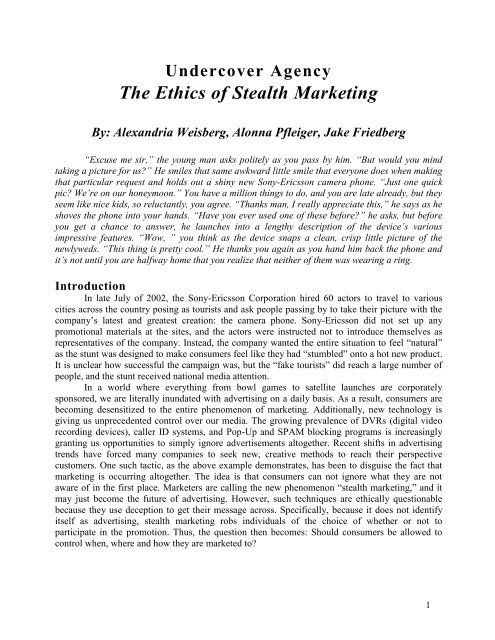
![Download Entire Book [PDF] - Ethicapublishing.com](https://img.yumpu.com/19531485/1/190x245/download-entire-book-pdf-ethicapublishingcom.jpg?quality=85)
![Download Entire Book [PDF] - Ethicapublishing.com](https://img.yumpu.com/19531484/1/190x245/download-entire-book-pdf-ethicapublishingcom.jpg?quality=85)
